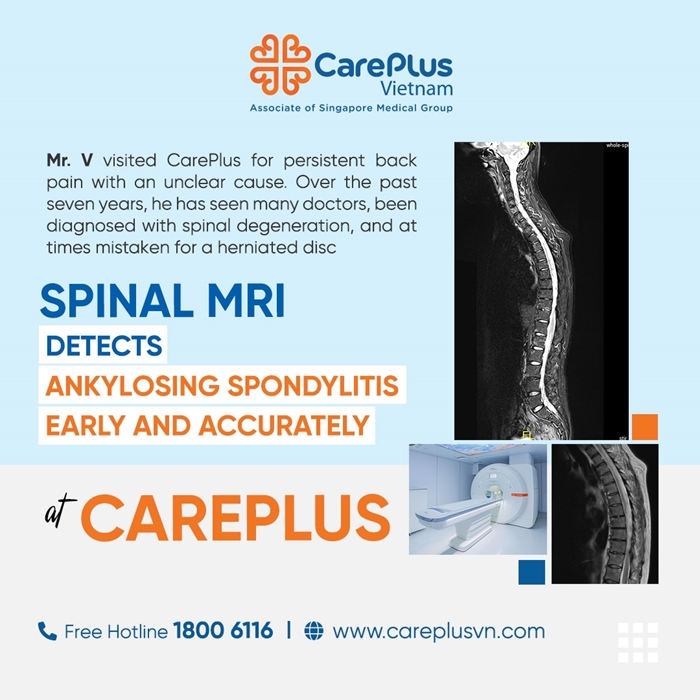SPINAL MRI DETECTS ANKYLOSING SPONDYLITIS EARLY AND ACCURATELY

4/4/2025 3:25:39 PM
Ankylosing spondylitis (AS) is a chronic inflammatory disease that primarily affects the sacroiliac joints and spine, causing pain, stiffness, and potentially leading to complete joint fusion. This condition has a genetic component and is more commonly found in young men than in women. However, due to its non-specific early symptoms, AS is often diagnosed late or mistaken for other musculoskeletal disorders.
Spinal MRI is an advanced imaging technique that enables early detection of ankylosing spondylitis, even when X-rays fail to reveal any abnormalities. This is crucial because early diagnosis allows for better disease management, reducing the risk of joint fusion and disability.
CLINICAL CASE
Mr. C.H.V (born in 1977, residing in Ho Chi Minh City) visited CarePlus due to persistent lower back pain that worsened at night and was accompanied by morning stiffness. Over the past seven years, he had sought medical consultations at multiple facilities and had been diagnosed with spinal degeneration, with some periods of misdiagnosis as a herniated disc. Despite undergoing various treatments, his symptoms only temporarily improved before recurring.
In the past six months, his back pain had intensified, and morning stiffness had become more pronounced. Upon evaluation at CarePlus, the rheumatologist suspected ankylosing spondylitis and recommended an MRI scan of the spine for a more in-depth assessment.
RESULTS
MRI findings revealed abnormal signal intensity at the anterosuperior and anteroinferior corners of the thoracic and lumbar vertebrae, showing high signal intensity on T2-weighted and STIR sequences, suggestive of Romanus lesions in the context of ankylosing spondylitis.
Diagnosis: Abnormal signal intensity at the anterosuperior and anteroinferior corners of the thoracic and lumbar vertebrae, highly suggestive of Romanus lesions associated with ankylosing spondylitis.
Following the MRI results, HLA-B27 testing was conducted, yielding a positive result, a significant immunological marker strongly associated with AS. Based on these findings, the patient was formally diagnosed with ankylosing spondylitis and transitioned to an appropriate treatment regimen. After three months, his back pain significantly decreased, mobility improved, and he regained a better quality of life.
SPINAL MRI – THE GOLD STANDARD FOR DIAGNOSING ANKYLOSING SPONDYLITIS
Previously, X-rays were commonly used to detect sacroiliac and spinal joint damage. However, X-rays only show abnormalities once the disease has progressed significantly. In contrast, MRI has high sensitivity, capable of detecting early inflammatory lesions even in the initial stages, when clinical symptoms are subtle and X-ray findings remain unremarkable.
BENEFITS OF SPINAL MRI IN THE DIAGNOSIS OF ANKYLOSING SPONDYLITIS
✅ Early detection of inflammatory lesions in the sacroiliac joints and vertebral bodies, allowing for diagnosis at an early stage.
✅ Assessment of disease severity and progression over time.
✅ Personalized treatment support, enabling physicians to tailor the treatment plan for better disease management.
✅ Non-invasive and radiation-free, making it a safer alternative to X-rays and CT scans.
WHEN SHOULD YOU CONSIDER A SPINAL MRI?
You should consider undergoing spinal MRI if you experience any of the following symptoms:
🔹 Chronic lower back pain lasting more than three months, worsening at night and in the morning.
🔹 Morning stiffness lasting over 30 minutes, improving with physical activity.
🔹 Lower back pain radiating to the buttocks, possibly associated with knee arthritis or tendon inflammation.
🔹 Unexplained fatigue, mild fever, or recurrent eye inflammation (uveitis).
If left undiagnosed and untreated, ankylosing spondylitis can lead to spinal fusion, kyphosis (hunchback), and loss of mobility. MRI plays a crucial role in early detection, opening doors to more effective treatment and preventing severe complications.
CAREPLUS – YOUR TRUSTED MEDICAL PARTNER
At CarePlus International Clinics, we provide state-of-the-art MRI and CT imaging services, supported by a highly specialized medical team. Our advanced diagnostic capabilities help detect spinal and musculoskeletal disorders with precision and efficiency.
💡 Don’t let chronic pain affect your quality of life!